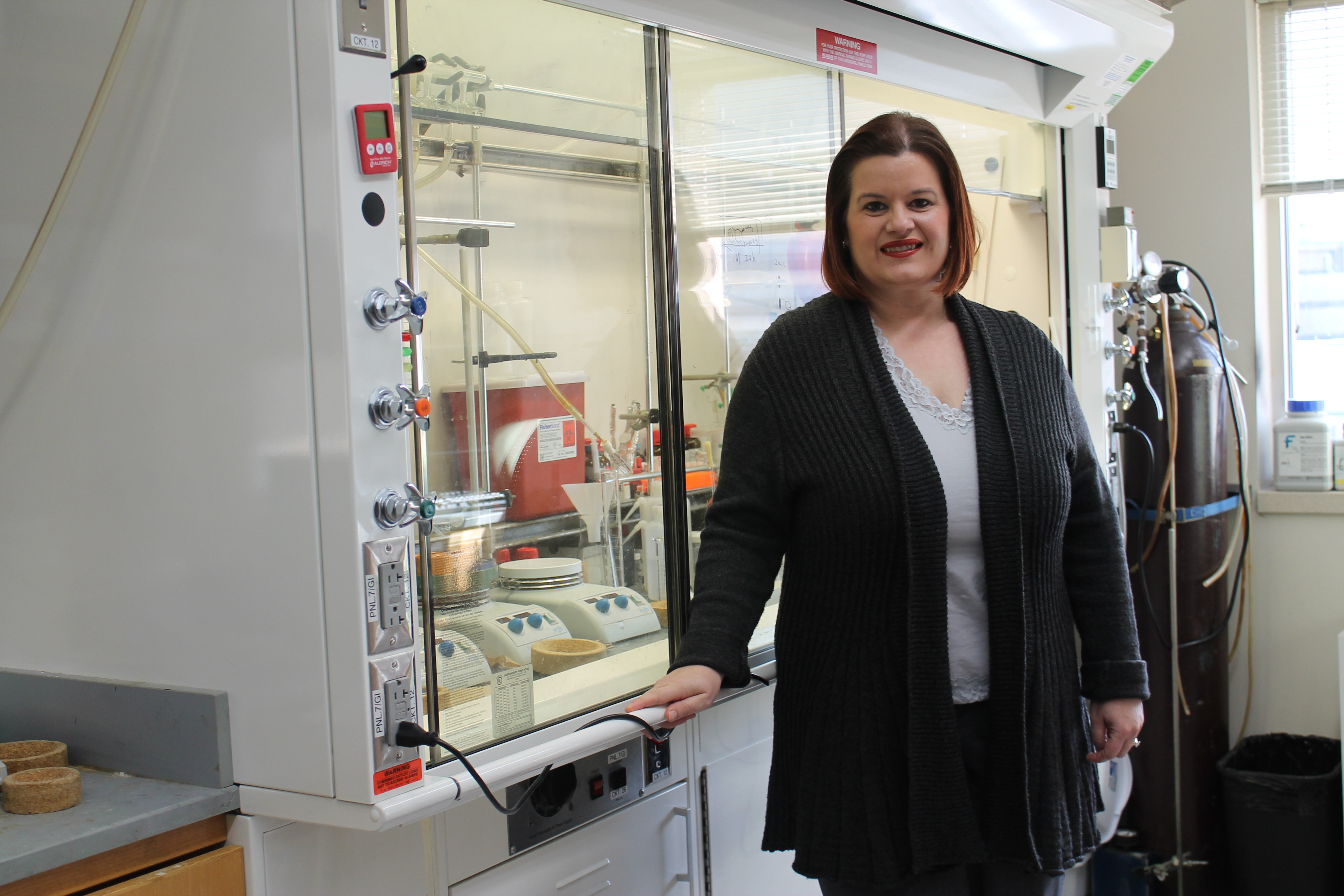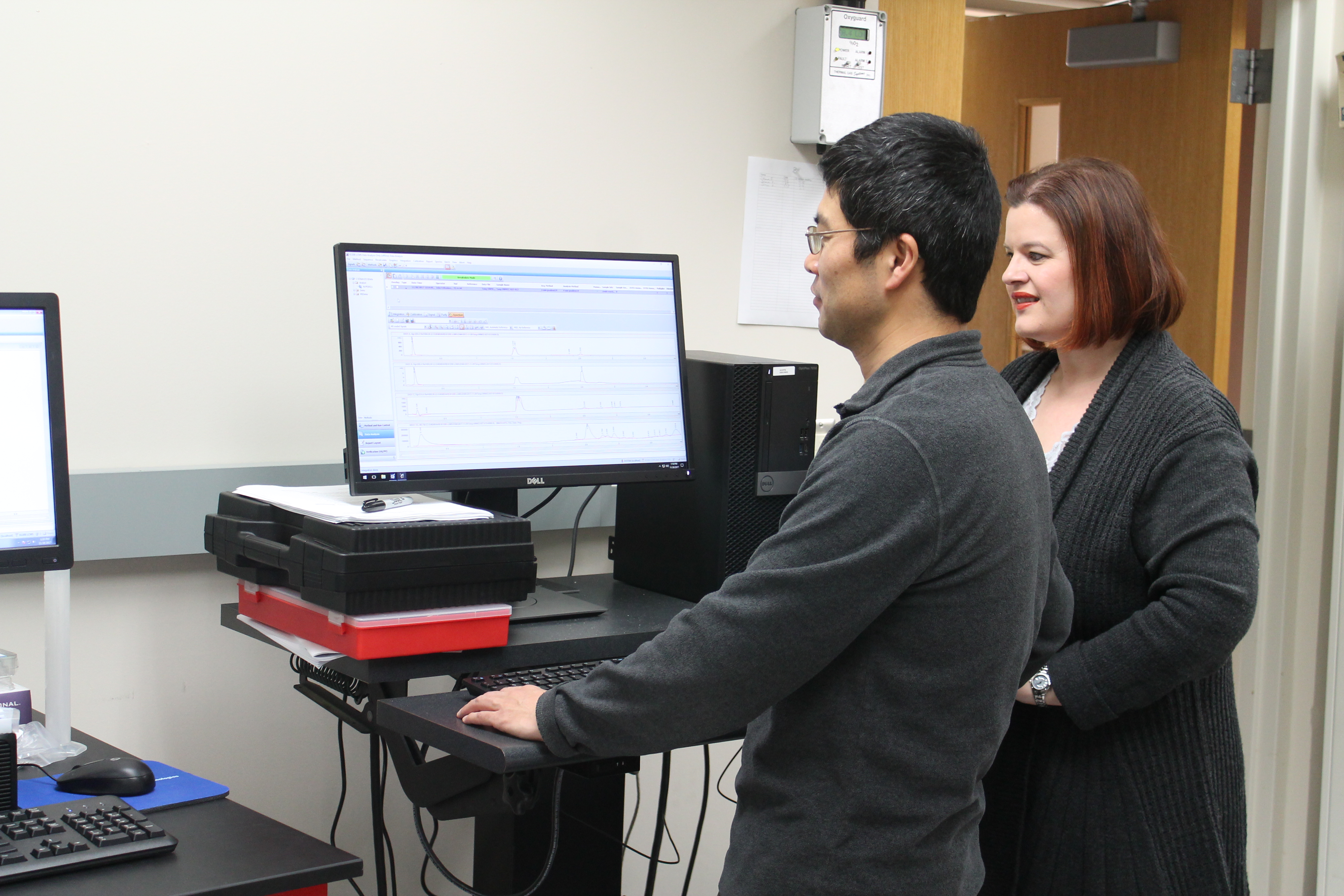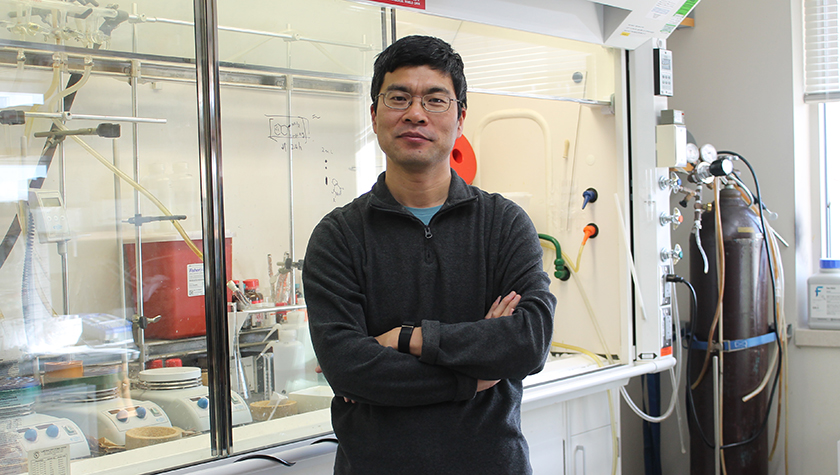From COVID-19 to encephalitic alphaviruses, School of Pharmacy Associate Professor Jennifer Golden and collaborators are developing new antiviral treatments
By Nicole Sweeney Etter
Viruses are everywhere: from the air we breathe to the pets and wildlife around us. But where some see only a potential threat to human health, Jennifer Golden sees the possibility of scientific breakthroughs.
Golden, an associate professor in the University of Wisconsin–Madison School of Pharmacy’s Pharmaceutical Sciences Division and associate director of the Medicinal Chemistry Center, designs novel drug-like molecules that interrupt viruses from copying themselves. When viruses can’t replicate, the host immune system has the chance to gain an advantage, mount a response, and clear the virus. As her team learns more about the types of molecules that are effective, they move closer to developing drugs that either prevent or treat viral infection.
Golden recently helped establish a new collaborative research center funded by the National Institutes of Health (NIH) to thwart emerging viruses before they reach pandemic level — one of three NIH-funded antiviral grants in her lab that range in focus from designing interventions for SARS-CoV-2 to creating first-in-kind clinical candidates against rare brain-attacking alphaviruses.
“We don’t know when a mutation is going to come up that allows a problematic virus to become more lethal or transmissible in humans.”
—Jennifer Golden
“We don’t know when a mutation is going to come up that allows a problematic virus to become more lethal or transmissible in humans,” Golden says. “There are pathogenic viruses circulating in the environment that currently lack the appropriate properties or conditions to cause widespread human disease. We are concerned about certain viruses — many of which we don’t have countermeasures for — that might acquire those characteristics and cause the next outbreak.”
Golden has long been intrigued by virology and designing molecules for their intervention.
“Despite their destructive impact, viruses are exquisite and fierce forces of nature,” she says. “We’re still living through the effects of COVID-19, and three years into it, we still have much to learn.”
To study viruses that have potential to cause catastrophic damage and understand how to intervene in their life cycle is an important part of what scientists do, she says.
“In my lab, we leverage our chemistry expertise by working with structural biologists, virologists, and many others to accomplish more than what any one of us can do on our own,” says Golden.
Early in her career, she was drawn to anti-infective development. “There’s tremendous opportunity for chemistry innovation in this work,” she says. “Besides, I continue to learn new aspects of biology and work with remarkable scientists outside my discipline. The more we learn collaboratively, the further we can push the science.”
Exploring lesser-known viruses
Over the past 15 years, the Golden Lab’s research has focused on building molecules that work against pathogens that don’t always get a lot of attention from the pharmaceutical industry. One such area involves alphaviruses, which are spread by infected mosquitoes and include pathogens that cause damage in either the brain or joints. For example, eastern equine encephalitis infection, also known as Triple E, can lead to brain inflammation and damage, while Chikungunya fever causes debilitating, long-term joint and muscle pain. The Golden team works on both, as well as others.

“Unfortunately, there are no approved vaccines or drugs available for any human alphavirus infection, and that puts us in a vulnerable position, especially if these viruses evolve to affect larger numbers of people,” she says.
For instance, in 2019, approximately 40 people in the United States were infected with Triple E, and only half of them survived. Even those who do survive can suffer from long-term symptoms ranging from seizures to paralysis to cognitive impairment.
“Triple E is a rare infection, but for those who do contract it, there is a significant chance that they either suffer dire consequences or have lasting effects for the rest of their lives,” she says. “As a scientist leading the charge in this area, we need to ask, ‘How do we change the odds in favor of the patients?’”
Golden is a principal investigator in the Center of Excellence for Encephalitic Alphavirus Therapeutics, an NIH-funded multidisciplinary research collaborative that was established in 2015. The team has developed small molecules to prevent and treat viruses like Triple E by targeting the virus in the brain and stopping it from replicating.
“I’m encouraged by the latest compounds in the pipeline,” she says. “Finding molecules that work well for these viruses teaches us how to broaden our impact, target other viruses, or even find other therapeutic applications. Those are very active areas right now that we’re pursuing.”
Finding novel ways to fight COVID
Through more support from the NIH, Golden is also advancing her work against a much more common pathogen: SARS-CoV-2, the coronavirus that causes COVID-19.
“It is another antiviral initiative that extends our chemistry programs out in a different direction,” she says.
While her lab was used to exploring lesser-known viruses, like Triple E, she was well-poised to pivot to SARS-CoV-2.
“As a scientist leading the charge in this area, we need to ask, ‘How do we change the odds in favor of the patients?’”
—Jennifer Golden
“My group had been building unique compounds with antiviral activity, so it was natural to ask if our chemistry and chemical libraries might hold some promise for a new problem,” she says. “With a world-wide lens held to SARS-CoV-2, viral proteins were revealed quickly that seemed like good targets for our chemistry and compounds.”
For that project, Golden leveraged not only her chemistry know-how and private compound collection, but she brought together the in-silico, or computer-based, modeling capabilities of Jerome Baudry at the University of Alabama-Huntsville and Jeremy Smith at the University of Tennessee-Knoxville, and the virology expertise of Colleen Jonsson from the University of Tennessee Health Science Center. Together, they integrate complementary resources into a single platform to quickly zero in on potential viral protein inhibitors and test them in cell and animal models. They currently have several compounds in the development queue that could inform SARS-CoV-2 interventions, while also providing insights on targeting other viruses of concern.
Developing the next generation of antiviral treatments
Most recently, Golden has helped to launch another new research center that pulls together global expertise. In 2022, the NIH’s National Institute of Allergy and Infectious Diseases funded nine Antiviral Drug Discovery (AViDD) Centers for Pathogens of Pandemic Concern to develop new antivirals for COVID-19 and other emerging viral threats. Golden was a sub-awardee on a $65 million grant to establish the Rapidly Emerging Antiviral Drug Development Initiative (READDI) AViDD center, based at the University of North Carolina–Chapel Hill.

“This center brings together resources and scientists from across the world with diverse skills and expertise in screening, virology, structural biology, medicinal chemistry, and drug development to address gaps in therapeutic options for several virus families of concern,” she says.
By building on existing work or launching new programs, the researchers hope to identify and develop new compounds to treat viral diseases deemed more likely to trigger a pandemic, including filoviruses (like Ebola and Marburg), coronaviruses (like SARS-CoV-2), and flaviviruses (like yellow fever, West Nile, and dengue).
As one of the experts in the new READDI AViDD Center, Golden provides hit-to-lead and lead optimization capability for compounds that are identified and developed for a broad collection of alphaviruses. The team is especially interested in finding treatments for Triple E, as well as the arthritis-causing alphaviruses such as Chikungunya, which is prevalent in India and has been steadily increasing in areas like Florida, Texas, and the Caribbean islands.
An eye on the future
In the future, Golden is interested in continuing to expand her reach to additional viruses, such as respiratory syncytial virus (RSV), which overburdened hospitals in Wisconsin and nationwide when it hit the pediatric population harder and earlier than usual this past year.
“Viruses tend to be very good at evolving and finding ways to maneuver around a given therapy, and sometimes a vaccine doesn’t work well for certain age groups or people with underlying conditions,” she says. “Having a small molecule drug as an alternative or combined therapy can be a powerful option.”
Wherever her research takes her next, she’s excited to creatively use chemistry to understand more about how to fight the world’s toughest viruses.
“If we are able to generate molecules that advance our understanding of the basic science of lesser known viruses, this enhances our chances of success in designing viable drugs for those viruses, and perhaps others — maybe even for the next pandemic, which we hope doesn’t come any time soon,” she says.
